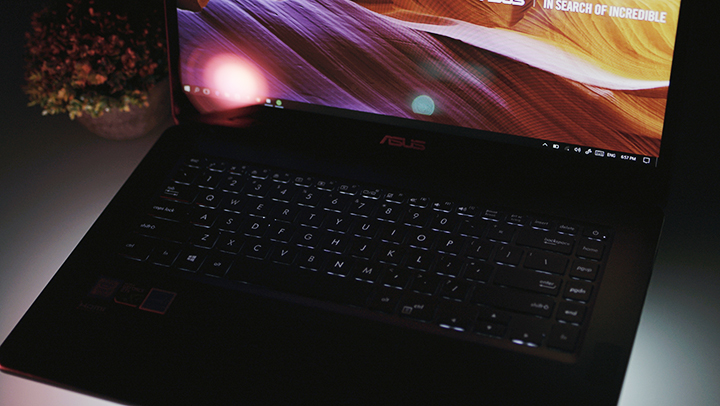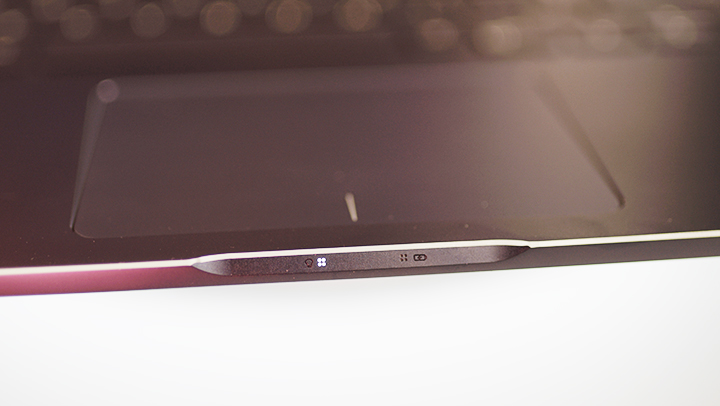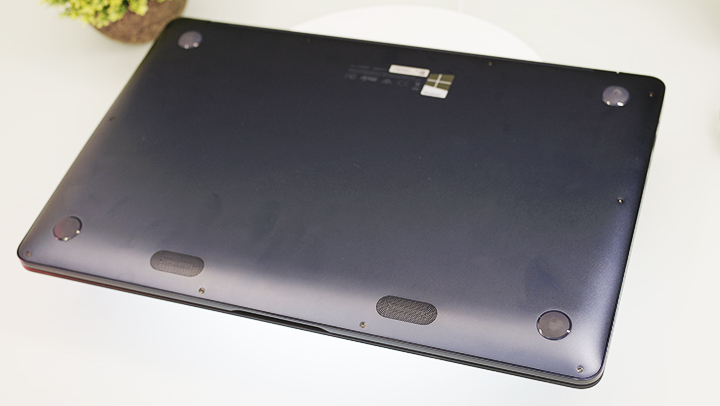ASUS created a lot of hype and buzz at Computex 2017 when they announced the newcomers to the ZenBook series. These new ultrabooks come with updated specs, an elegant design, and a slim form factor. The most hotly anticipated member among the new line-up, though, is the updated ZenBook Pro, as it brings performance along with portability to the table.
ASUS‘ new ultrabook comes in two variants, what we’re taking a look at here is the Full HD version of the higher specced one — the ZenBook Pro UX550VE. We already have an initial hands-on of the device here, but this time around, we were able to spend a little more time with it.

The ZenBook series is known to have laptops with elegant designs, and the ZenBook Pro UX550VE is no exception to that. The notebook’s lid dons the signature Zen-inspired spun-metal finish design with the familiar silver ASUS logo at the center, which also lights up when the laptop is in use. It has a solid-aluminum unibody that is covered with a Royal Blue finish. Unlike the Vivobook series that makes use of a two-tone color scheme, ASUS’ ZenBooks only have one color, which makes it look seamless and actually adds to the device’s elegance. The notebook’s looks are short of impressive and you can really tell that you’re holding a premium device.

Apart from its elegant looks, it also has a very well-constructed body. There is little to no flex at all on any of its parts including its screen and keyboard deck. You can even lift the lid with one-hand albeit with a bit of a challenge, but that is still one indicator that the hinge, and the laptop’s body in general, are well made. The UX550VE may look elegant but it’s certainly built like a tank and even though its weight can be felt, it’s still light enough to be carried around as a daily driver.
Sadly, it’s one hell of a fingerprint magnet, so be sure to always have a microfiber cleaning cloth ready. Another downside is that even though it has two exhaust vents at the back, those vents are caved into the body and are fully blocked by the display’s hinge. With this kind of set-up, the notebook is unable to breathe, and that problem surfaced when we tried gaming on it. More on that later.

As we’ve mentioned earlier, this ZenBook Pro is equipped with a Full HD (1920 x 1080) display. The screen size is 15.6-inches, but the panel is at 14-inches. The device makes use of ASUS’ NanoEdge display which essentially means it has slimmer all-around bezels. That display tech is also the reason how the company was able to put a 15.6-inch screen on a 14-inch panel. Apart from making it slimmer, the laptop was able to achieve a screen to body ratio of 83% thanks to those thinner bezels.

The display itself uses a touch-enabled IPS panel. It has good color reproduction, accuracy, and viewing angles, and registers gestures and swipes easily. It does lean towards warmer colors though, which you would immediately notice upon first use. It can get bright enough for outdoor use but the glossy screen will most likely hamper operations. ASUS had to use a glossy screen though to enable touch support.
The company claims that the display covers 100% of the sRGB color gamut spectrum. If this is true, then color accurate work may also be possible. Either way, the display is above average and avid fans of movies and TV series would have a good viewing experience. As for its 100% sRGB color reproduction, we’ll have to test that further.

The speakers on this device are stunning. ASUS did well in partnering with renowned audio company Harman/Kardon. The Mids, Highs, and Lows are all present and with amazing audio quality. The speakers can also go really loud, as it even became very audible in the next room at just 50% volume. It impressively maintains clarity, including quality, even at max volumes. Looks like the notebook’s quad-speaker set-up paid off. Audiophiles will certainly love the audio quality on this laptop.

Let’s move on to the keyboard and trackpad. The ZenBook Pro UX550VE is equipped with your standard laptop chiclet keyboard. In-line with its 14-inch form factor, we are given a TKL (Tenkeyless, or no NumPad) layout, but with extra function buttons on the right. Typing and gaming is a pleasure as the keyboard has short yet good travel distance and excellent tactile feedback. Night operations are also possible since the keyboard has adjustable backlighting. It’s also worth noting that keyboard lights automatically turn off after a few seconds of inactivity, a subtle yet useful feature that saves battery. Be mindful, however, of the keyboards arrow keys as they are smaller than usual and might cause some wrong key presses at times.

The trackpad, on the other hand, is a precision touchpad (supports four-finger smart gestures) and a ClickPad meaning the whole pad could be clicked in order to register commands. It still has those dividers on the bottom to distinguish left and right click functions, but users could simply single tap to register a left click or tap the pad with two fingers to register a right click. The trackpad itself has a smooth surface and registers gestures and commands quickly. Clicks are also springy and have good acoustics and haptic feedback. Users who are accustomed to using a trackpad would be pleased with this one.
Our unit doesn’t include one, but there is a variant with a fingerprint scanner. It would have been nice though if ASUS included it on all the variants especially at this price point.
As for I/O, on the right, we have two USB 3.1 Gen 1 Type-A ports, a microSD card reader, and a combo audio jack. On the other side, we have the power input, an HDMI port, and two USB 3.1 Gen 2 Thunderbolt 3 Type-C ports. The inclusion of two Thunderbolt 3 ports are a plus and ASUS even included a USB Type-A to Ethernet port adapter to complement the loss of a built-in one. However, we were only given a microSD card reader instead of a full-size one, and all the Type-A ports are positioned on the right. This port positioning could prove to be a nuisance and would require users to purchase an adapter if they wish to connect non-Type-C devices on the notebook’s left side.

All the hype for the ZenBook Pro UX550VE was not just because it’s a slim device, but also because it packs quite a punch. It is powered by Intel’s 7th Generation i7-7700HQ, Nvidia’s GTX 1050Ti, and 16GB of RAM. This setup is enough to warrant it as a gaming and even a photo and video editing laptop. As such we tested its gaming capabilities by playing Dauntless, a monster-slaying game that is currently on closed beta. We tried to set the graphics settings to achieve 60fps or at least close to it. With settings set to medium and at the native 1080p resolution, the laptop reached an average of 34.46 fps which is acceptable, to say the least. We will be testing out more games, so stay tuned for our full review.

Now let’s talk about that cooling set-up we mentioned earlier. We were right that the laptop was unable to breathe, and it struggled to keep its components cool. Apart from the evident heat on the center and top side of the keyboard deck and the display panel, the laptop’s fans also immediately roared once we started the game. Not to mention the blast of hot air was also directed upward towards the front of the display, since that is the only open airway, as the original opening of the exhaust vents are now fully blocked by the display panel’s hinge. This is clearly a design flaw by ASUS. Let’s see how the laptop fares though once we stress it out during our full review.

The ZenBook Pro UX550VE is certainly an interesting device and lived-up to the hype to some degree. Underneath that elegant design is a powerful yet slim device with amazing speakers and an above average display. Although, that serious firepower in a small form factor does come with a price, which is heat. ASUS made a huge mistake with the notebook’s cooling system. It also has weird port positioning that might prove to be a nuisance in the long-run. The biggest problem consumers will face though is the notebook’s price, which starts at a staggering Php 104,995USD 1,789INR 151,676EUR 1,704CNY 13,030. Either way, we’ll put the laptop through its paces in our review to fully test its capabilities and to see whether or not users can look past its surfacing disadvantages.
ASUS ZenBook Pro (UX550) specs:
15.6-inch Full HD / 4K UHD NanoEdge display (Touch Optional)
Intel Core i5-7300HQ / Core-7-7700HQ CPU
NVIDIA GeForce 1050 Ti / 1050 GPU, 4GB DDR5 VRAM
8GB / 16GB DDR4
1TB / 512GB PCIe SSD
512GB / 256GB SATA3 SSD
2x USB 3.1 Type-C Gen 2 (Thunderbolt 3)
2x USB 3.1 Type-A USB 3.1 Gen 1
HDMI
Combo audio jack
MicroSD card reader
Full-size backlit keyboard, 1.5mm travel
Precision touchpad
Quad speakers (3W each), certified by Harman Kardon
VGA Webcam
Dual band 802.11 ac WiFi
Bluetooth 4.2
Windows 10 Pro / Home
73Wh 8-cell Li-Po battery
36.5 x 25.1 x 1.89 cm
1.8Kg
Royal Blue, Matte Black

YugaTech.com is the largest and longest-running technology site in the Philippines. Originally established in October 2002, the site was transformed into a full-fledged technology platform in 2005.
How to transfer, withdraw money from PayPal to GCash
Prices of Starlink satellite in the Philippines
Install Google GBox to Huawei smartphones
Pag-IBIG MP2 online application
How to check PhilHealth contributions online
How to find your SIM card serial number
Globe, PLDT, Converge, Sky: Unli fiber internet plans compared
10 biggest games in the Google Play Store
LTO periodic medical exam for 10-year licenses
Netflix codes to unlock hidden TV shows, movies
Apple, Asus, Cherry Mobile, Huawei, LG, Nokia, Oppo, Samsung, Sony, Vivo, Xiaomi, Lenovo, Infinix Mobile, Pocophone, Honor, iPhone, OnePlus, Tecno, Realme, HTC, Gionee, Kata, IQ00, Redmi, Razer, CloudFone, Motorola, Panasonic, TCL, Wiko
Best Android smartphones between PHP 20,000 - 25,000
Smartphones under PHP 10,000 in the Philippines
Smartphones under PHP 12K Philippines
Best smartphones for kids under PHP 7,000
Smartphones under PHP 15,000 in the Philippines
Best Android smartphones between PHP 15,000 - 20,000
Smartphones under PHP 20,000 in the Philippines
Most affordable 5G phones in the Philippines under PHP 20K
5G smartphones in the Philippines under PHP 16K
Smartphone pricelist Philippines 2024
Smartphone pricelist Philippines 2023
Smartphone pricelist Philippines 2022
Smartphone pricelist Philippines 2021
Smartphone pricelist Philippines 2020
Wayne Thomas Haas says:
Thanks for the article…as I have owned several Asus notebooks and laptops. My most expensive rig was around 38,000 Pesos. Odd how prices now climb into the stratospere.
I spied one word that should be edited:” fairs” should be spelled “fares.”